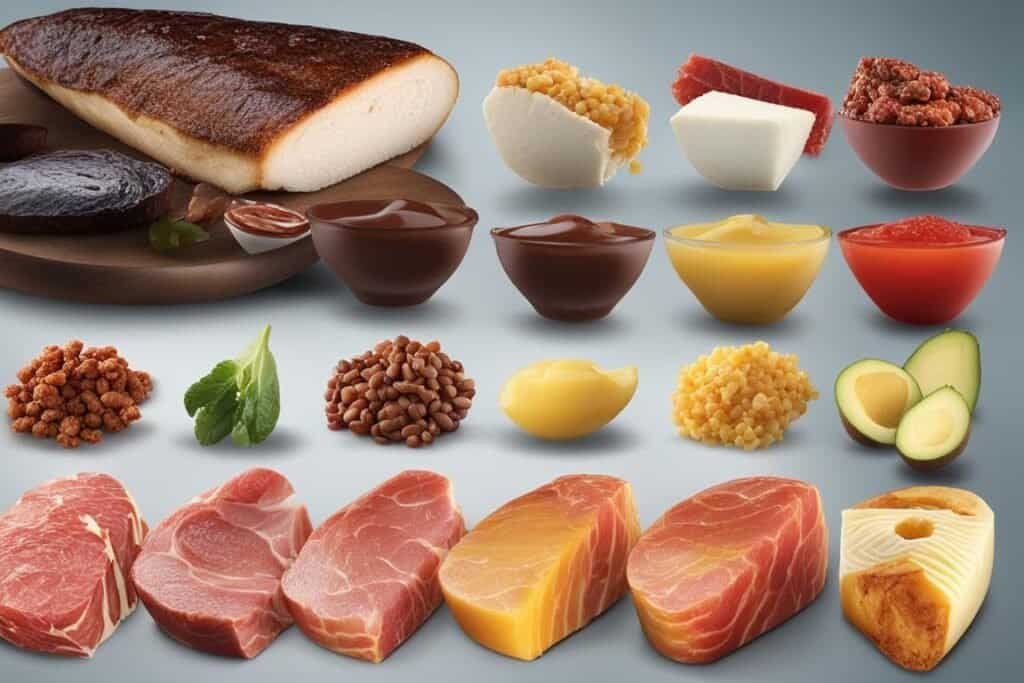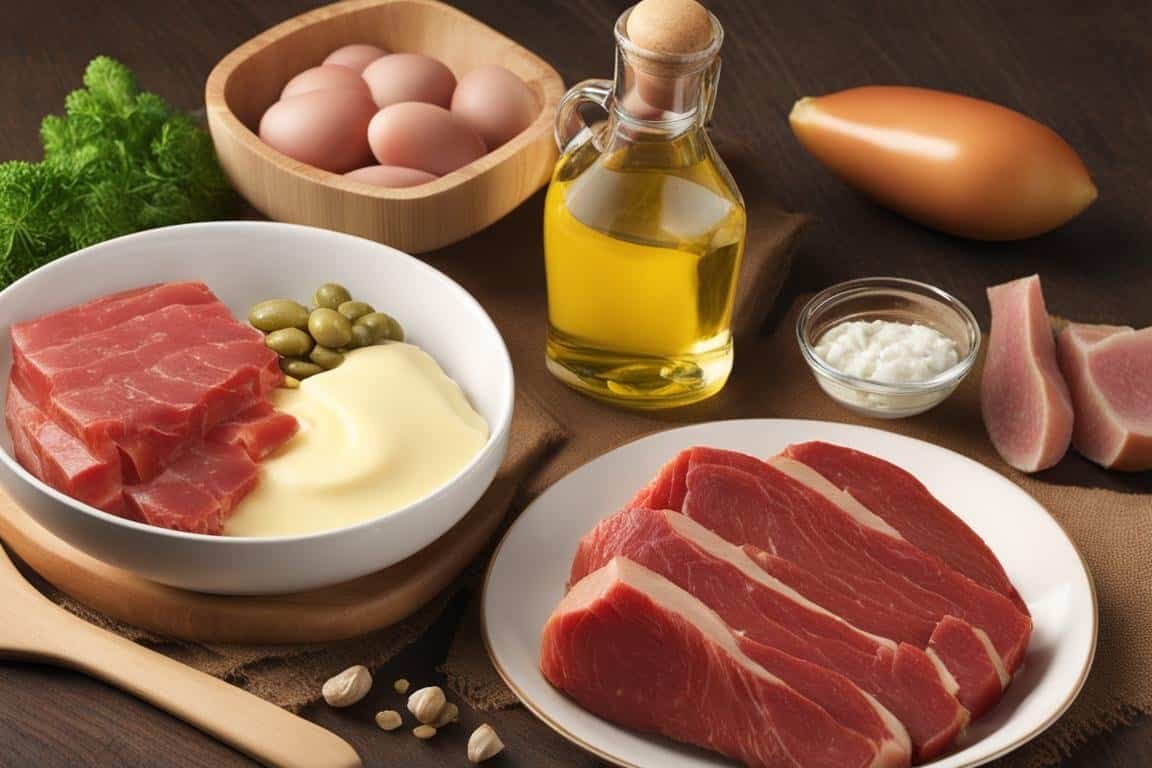What is Fat?
Fats are a type of lipid, which is a class of biomolecules that are insoluble in water but soluble in organic solvents. They play a crucial role in our bodies and are composed of fatty acids attached to a glycerol backbone.
There are different types of fats, each with its own characteristics and effects on our health. It’s important to understand these types to make informed dietary choices:
- Saturated Fats: These fats are solid at room temperature and are mostly found in animal sources like red meat and full-fat dairy products. They can increase cholesterol levels and pose a risk to cardiovascular health.
- Trans Fats: These fats are also solid at room temperature and are commonly found in processed foods like fried and baked goods. They can raise bad cholesterol levels and increase the risk of heart disease. It is best to avoid trans fats as much as possible.
- Unsaturated Fats: These fats are liquid at room temperature and are generally considered healthier options. They can help control cholesterol levels when consumed in moderation.
- Polyunsaturated Fats: Found in foods like fatty fish, flaxseed, and walnuts, these fats can help lower bad cholesterol levels.
- Monounsaturated Fats: Olive oil, avocados, and nuts are examples of foods rich in monounsaturated fats, which can also help lower bad cholesterol levels.
By understanding the different types of fats and their effects on our bodies, you can make healthier choices and maintain overall well-being.
What is Cholesterol?
Cholesterol is a waxy compound that is naturally produced by the liver and is present in all cells of the body. It plays a crucial role in building cell membranes and is essential for various bodily functions.
Cholesterol can be found in certain foods, including red meat, cheese, butter, and eggs. These dietary sources contribute to the overall cholesterol levels in the body.
Cholesterol is transported through the bloodstream by lipoproteins, which are specialized particles that carry cholesterol and other fats. The two main types of lipoproteins involved in cholesterol transport are low-density lipoprotein (LDL) and high-density lipoprotein (HDL). LDL is often referred to as “bad” cholesterol, as elevated levels can contribute to the buildup of plaque in the arteries. HDL, on the other hand, is known as “good” cholesterol as it helps remove excess cholesterol from the bloodstream.
| Food Sources of Cholesterol | Cholesterol Content (mg per 100g) |
|---|---|
| Egg Yolk | 1230 |
| Shrimp | 152 |
| Liver (Beef) | 411 |
| Cheddar Cheese | 95 |
Elevated levels of cholesterol in the bloodstream can increase the risk of cardiovascular diseases such as heart attack and stroke. It is important to manage cholesterol levels through a combination of dietary choices, regular exercise, and medications if necessary.
Understanding the sources and functions of cholesterol allows individuals to make informed decisions about their diet and lifestyle to maintain optimal health.
Difference between Fat and Cholesterol
Understanding the difference between fat and cholesterol is essential for making informed dietary choices. While both fat and cholesterol play important roles in the body, they have distinct functions and sources.
Fat:
Fat is a macronutrient that provides energy to the body. It is a concentrated source of calories and serves as a fuel reserve. Fat can be derived from various sources, including animals and vegetable oils. It is further categorized into different types:
- Saturated fats: These fats are mainly found in animal-based foods like butter, lard, and fatty cuts of meat. They are typically solid at room temperature.
- Trans fats: Trans fats are artificially created through a process called hydrogenation. They are often found in processed foods, such as fried snacks and baked goods.
- Unsaturated fats: These fats are liquid at room temperature and include both polyunsaturated and monounsaturated fats. They can be found in plant-based oils, nuts, and seeds.
Fat is necessary for the body as it helps absorb fat-soluble vitamins and provides essential fatty acids. However, consuming excessive amounts of saturated and trans fats can increase the risk of heart disease and contribute to high cholesterol levels.

Cholesterol:
Cholesterol, on the other hand, is a waxy substance primarily found in animal-based foods. It is not a source of energy as it does not provide calories. Cholesterol is classified into different types:
- Triglycerides: Triglycerides are the most common type of fat found in the body. They circulate in the bloodstream and serve as a storage form of energy.
- LDL cholesterol: Low-density lipoprotein (LDL) cholesterol is often referred to as “bad” cholesterol. High levels of LDL cholesterol can contribute to the development of plaque in the arteries.
- HDL cholesterol: High-density lipoprotein (HDL) cholesterol is known as “good” cholesterol. It helps remove LDL cholesterol from the bloodstream and promotes heart health.
- VLDL cholesterol: Very-low-density lipoprotein (VLDL) cholesterol is similar to LDL cholesterol and contains a high proportion of triglycerides.
Cholesterol is essential for building cell membranes and producing hormones. However, high levels of LDL cholesterol and triglycerides can increase the risk of heart disease.
In conclusion, while fat provides energy, cholesterol does not. Fat can be derived from various sources and is categorized into different types, including saturated, trans, and unsaturated fats. Cholesterol, on the other hand, is primarily found in animal-based foods and is classified into triglycerides, LDL cholesterol, HDL cholesterol, and VLDL cholesterol. Understanding the difference between fat and cholesterol is crucial for managing overall health and making informed dietary choices.
The Impact of Saturated Fat on Health
Consuming excessive amounts of saturated fat can have negative effects on your health. Saturated fats are primarily found in animal sources such as red meat and full-fat dairy products. These fats can raise cholesterol levels, particularly LDL cholesterol, which is often referred to as “bad” cholesterol.
High levels of LDL cholesterol contribute to an increased risk of heart disease. Research has shown that a diet high in saturated fat can lead to the accumulation of cholesterol in the arteries, narrowing them and restricting blood flow. This can increase the likelihood of heart attacks and strokes.
It is important to limit the intake of saturated fats and replace them with healthier alternatives. Incorporating foods that are rich in unsaturated fats, such as avocados, nuts, and olive oil, can help in reducing the risk of cardiovascular problems. These healthy fats can improve cholesterol levels and support heart health.
| Saturated Fat Sources | Saturated Fat Content (per 100g) |
|---|---|
| Butter | 54g |
| Beef | 20g |
| Pork | 18g |
| Full-fat Cheese | 17g |
| Chicken Skin | 16g |
| Coconut Oil | 86g |
| Palm Oil | 49g |
Table: Sources of Saturated Fat
Managing Cholesterol and Saturated Fat Intake
To effectively manage your overall health and reduce the risk of heart disease, it is crucial to follow dietary recommendations for managing cholesterol and saturated fat intake. By implementing these guidelines, you can take control of your cholesterol levels and reduce the consumption of saturated fats.
The American Heart Association advises limiting the intake of saturated fat to lower LDL cholesterol levels. LDL cholesterol, also known as “bad” cholesterol, can increase the risk of heart disease. It is recommended that less than 10% of your daily calories come from saturated fat.
To reduce cholesterol levels, it is advisable to consume a diet low in saturated fat and high in fiber, fruits, vegetables, and whole grains. These foods are not only low in cholesterol but also rich in nutrients that support heart health. You can include foods like oats, barley, legumes, fruits, and vegetables in your meals to effectively manage your cholesterol levels.
Additionally, regular exercise and maintaining a healthy weight play a vital role in managing cholesterol levels. Engaging in physical activity for at least 30 minutes a day can help improve your overall cardiovascular health and contribute to reducing cholesterol levels. Try incorporating activities like brisk walking, jogging, cycling, or swimming into your daily routine.
By following these dietary recommendations and leading an active lifestyle, you can effectively manage your cholesterol intake, reduce cholesterol levels, and lower the consumption of saturated fats, ultimately promoting a healthier heart and overall well-being.

Sources of Cholesterol and Saturated Fat in the Diet
When it comes to managing cholesterol and saturated fat levels in your diet, it’s essential to be aware of the sources of these substances. By understanding which foods are rich in cholesterol and saturated fat, you can make informed choices to promote a healthier lifestyle.
Cholesterol-Rich Foods:
- Red Meat: Beef, lamb, and pork have higher cholesterol content compared to other protein sources.
- Organ Meats: Liver, kidney, and brain are particularly high in cholesterol.
- Shellfish: Shrimp, crab, and lobster contain moderate levels of cholesterol.
- High-Fat Dairy Products: Cheese, butter, and whole milk are examples of dairy products with higher cholesterol.
Saturated Fat-Rich Foods:
- Fatty Cuts of Meat: Beef, pork, and lamb with visible fat are high in saturated fat.
- Poultry with Skin: Chicken and turkey skin contain significant amounts of saturated fat.
- Full-Fat Dairy Products: Whole milk, full-fat yogurt, and regular cheese are sources of saturated fat.
- Butter: This dairy product is rich in saturated fat and should be consumed in moderation.
- Coconut and Palm Oil: These plant-based oils are high in saturated fat and often used in processed foods.
To manage your cholesterol and saturated fat intake, consider choosing leaner sources of protein, such as skinless poultry, fish, and legumes. Opt for low-fat dairy products or alternatives like almond milk or Greek yogurt. When cooking, use healthier oils like olive oil or avocado oil instead of coconut or palm oil. By making these dietary adjustments, you can reduce your consumption of cholesterol and saturated fat, promoting a healthier cardiovascular system.
Conclusion
Understanding the difference between cholesterol and saturated fat is crucial for making informed dietary choices and optimizing your overall wellness. While cholesterol is a necessary component of cell membranes, excessive levels can contribute to cardiovascular disease. On the other hand, consuming too much saturated fat can raise cholesterol levels and increase the risk of heart problems.
By managing your cholesterol and saturated fat intake through recommended dietary choices, you can significantly reduce your risk of cardiovascular issues and improve your overall health. It is recommended to limit the intake of saturated fats and choose healthier alternatives, such as lean sources of protein, low-fat dairy products, and healthier oils. Additionally, incorporating regular exercise and maintaining a healthy weight can further support the management of cholesterol and saturated fat levels.
Optimizing your wellness is not just about managing cholesterol and saturated fat, but also about making healthier food choices and leading an active lifestyle. By taking control of your diet, exercising regularly, and making conscious decisions about your overall well-being, you can pave the way for a healthier and more fulfilling life.

